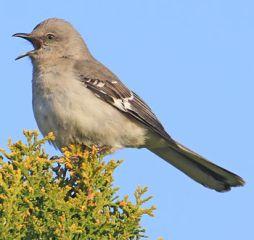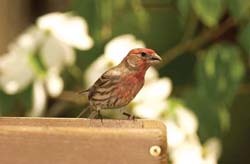Spring Birdsong

Why Birds Sing
Birds make many sounds to communicate. Often they will have different sounds to stay in contact, beg for food, or signal aggression, for example. But most well known is the phenomenon of song: these longer, often musical series of notes are the center of spring's soundtrack. As temperatures warm and days lengthen, birds respond physiologically to environmental cues, with song one of the first behaviors of the incipient nesting season. As male bids defend territories with more diligence, singing helps advertise an individual's presence and readiness to defend his patch from potential rivals, while demonstrating his good health and vigor to potential mates.
Such is the use of songs for birds. For us humans, bird songs are an integral part of learning to identify different species. In addition to their intrinsic beauty, songs can be used to confirm the identity of poorly seen birds and to alert us to the presence of different species before we ever see them.
How to Learn Birdsong
The best way to learn is perhaps the simplest: when you hear a bird singing, go look and see who it is! Sometimes, of course, it's hard to see who is singing, and we are all apt to forget who sounded like what after a while. The most valuable technique is to mentally (or physically, if you're a note-taking type) transcribe the song into terms your brain will remember, whether by similar sounding English words (the California Quail's "Chi-CA-go!" call), by as close a phonetic rendering as you can get with our alphabet (something like cu-CA-cow might be close), or by description ("three loud syllables, with the second one loudest and most strongly accented"). Even musically-minded people like Michael Redgrave's ethnomusicologist in The Lady Vanishes are prone to forget pure melodies, even when the fate of the free world rests in their hands. That's why it is vital to use some kinds of words to describe the songs you hear birds making – that's how people think, and that's by far the most effective way for us to remember.
Most field guides have some kind of written representation of songs and calls; it can be useful when you hear a song to see how your field guide author chose to render it and try to mentally overlay that description the next time you hear the song. Some other good resources are All About Birds, where recordings of most birds (with descriptions) can be found, local CDs with helpful commentary that we sell at the store, or bird guide apps like iBird, which include playable songs and calls for each species.
Ten Common Yard Birds
1. California Quail: While not exactly a typical song, the quail's territorial/assembly call provides an easy illustration of how to think about bird sounds as described above. Do you heard "Chi-ca-go!" or "cu-CA-cow!" or do you find it easiest just to describe it as "three loud syllables, with the second one loudest and most strongly accented"? (If audio player does not appear below, you can hear the recording at bird audio archive xeno-canto.)
2. Mourning Dove: The famous coo-oo-oo-oo, not to be confused with the night-time call of the Great-horned Owl.
3. House Finch:  Song a varied, lilting warble; often ends with a long veeerrr note slurred either upward or downward. This is one of our most common songs; stop and listen outside the store the next time you visit us. The first recording on Cornell's All About Birds site gives a good representative performance.
Song a varied, lilting warble; often ends with a long veeerrr note slurred either upward or downward. This is one of our most common songs; stop and listen outside the store the next time you visit us. The first recording on Cornell's All About Birds site gives a good representative performance.
4. Lesser Goldfinch: Song is long combination of variable notes and phrases repeated randomly in rambling, intricate melody; may contain imitations of other species' calls. Their scientific name is Spinus psaltria; a psaltria is a lyre player - a recognition of their musical talents. Our less abundant American goldfinches have a similar, but faster, song. (If audio player does not appear below, you can hear the recording at bird audio archive xeno-canto.)
5. Golden-crowned Sparrow: You may have heard this winter resident singing soon after his arrival in the fall, as well as sporadically throughout the winter, especially after rain. They often begin to sing a little more often as weather warms in spring, before their departure (in March and April) for northern breeding grounds. Their song is a distinctive series of three clearly whistled, descending notes, though you will often hear only two, and occasionally four.
6. Dark-eyed Junco: A brief, light, dry trill; somewhat musical or bell-like.
7. Oak Titmouse: Repeated series of 3–7 syllables, each made up of coupled notes alternating from high to low frequency and with whistled quality: peter peter peter. One of the earliest songs to start in spring, heard early in the morning from late January.
8. Bewick's Wren: A fast-paced and variable song, but listen for a typical wren-like buzz near the beginning, after a few introductory pick-up notes, and then an ending of 4–6 or so quick, staccato, but clear and piercing whistles, sometimes turning into a faster many-noted trill. Here's a relatively short and simple one, so it's easier to pick out those distinctive essentials which are often buried in the midst of a longer musical jumble: (If audio player does not appear below, you can hear the recording at bird audio archive xeno-canto.)
9. American Robin: Evenly spaced carol resembling cheerily, cheer-up, cheerily or plurrri, kliwi, plurrri, kliwi; often a series of two or three short phrases, rising and then falling, alternately repeated over and over. Visit All About Birds to hear a few samples of robin songs.
10. Northern Mockingbird: The song is a long series of phrases, with each phrase usually repeated three times or more; the songs can go on for 20 seconds or more. Phrases may be imitations of other birds, other natural sounds, or manmade sounds, such as car alarms. Both males and females sing; unpaired males are the most vigorous singers and may even sing at night in spring.

